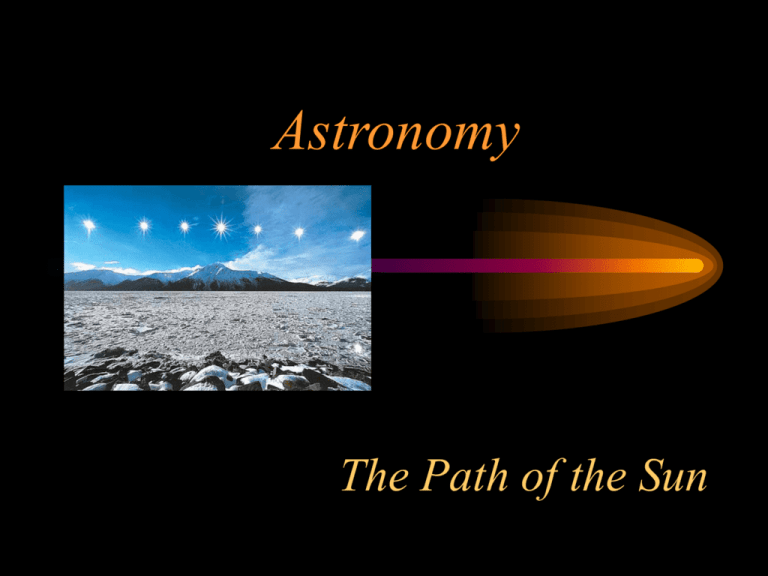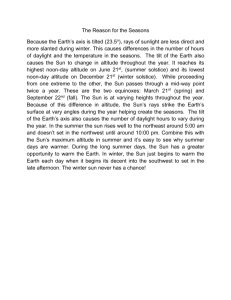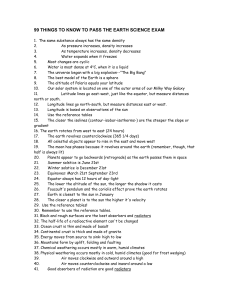The Path of the Sun
advertisement

Astronomy The Path of the Sun • Have you ever noticed how the sun moves across the sky during the course of a day? • Does the sun change its path through the sky from month to month? • Are there certain times when you know through which part of the sky the sun will travel? • These questions are best answered if you have an entire year to make observations of the Sun to see how its movement through the sky varies. • Since we do not have an entire year to observe the Sun, lets take a look at a few key terms and concepts that may help you understand the Sun's motion. . . The Path of the Sun • An arc is the apparent path the sun takes across the sky. • The sun appears to move across the sky (arc) from east to west because Earth rotates on its axis. • Hemispheres are equal divisions of the Earth. • The Earth is divided into four hemispheres: – North, south, east and west. • Local Solar Noon is the time when the sun is at its highest point of the day; does not necessarily have to occur at 12:00 o’clock, noon. • The sun only reaches an altitude of 90º in the tropics! In NYS it only reaches a maximum altitude of ~ 73°, and even that’s only for a day! • The point in the sky located directly above an observer is called the Zenith. • An observer’s zenith is always 90 degrees. • Azimuth is the direction of an object measured clockwise around an observer along the horizon. – – – – – North = 0º East = 90º South = 180º West = 270º Back to North 360º • The angle of an object above the horizon is its altitude. • An object’s altitude can range from 0º to 90º. – 0º = horizon – 90º = zenith Altitude and azimuth are always used together . . . • Altitude – Angle UP • and • Azimuth – Angle AROUND Does the Sun ‘Rise in the east and set in the west’ ? Sort of . . . • Many people know that the Sun rises in the east and sets in the west, but does NOT rise EXACTLY east and set EXACTLY west every day? • We also know that the days are longer in the summer and shorter in the winter, but have you ever thought about how the Sun's path through the sky is changing to create these differences? • The path of the sun changes over the course of the year because of Earth’s TILT and REVOLUTION. • We’re facing the sun in the summer, so it appears in the sky longer. We’re facing away from the sun in the winter, so it is in the sky for a much shorter period of time. • Thus, between the summer solstice and the winter solstice the sun moves in a changing arc across the sky; it covers 242 degrees of azimuth in the summer and only 114 degrees of azimuth in the winter ~ less than half of the summer arc! Summer Solstice • On June 21st, the Sun is at its highest declination (altitude), (+23.5 degrees from the altitude at equinox; 71.5 degrees). • The path of the Sun on that day is longest, so the length of the daylight hours is longest. • It rises NORTH of East and sets NORTH of West. Equinox • • • • • Equi = Equal / Nox = night Equinox means equal night (and equal day!) 12 hours of day and 12 hours of night everywhere on the globe. Occurs around March 21 (Spring) and September 21 (Fall) At our location in New York, the sun’s altitude on the equinox is 48 degrees. • The sun rises exactly east (90°E) and sets exactly west (270°W) Winter Solstice • On Dec 21st, the Sun is at its lowest declination, (-23.5 degrees from our altitude at the equinox; 24.5 degrees). • The path of the Sun on that day is shortest, so the length of the daylight hours is shortest. • The sun rises SOUTH of east and sets SOUTH of west. Only the shadow knows . . . • Ever notice how the length of your shadow changes throughout the day, depending on what time you’re outside? • It changes with the seasons, too! • Shadow length is determined by the altitude of the sun. • The higher the sun is in the sky, the shorter the shadow (inverse relationship). • i.e. ~ longer shadows in the morning and evening, shorter shadows at noon; longer shadows in the winter, shorter shadows in the summer. Final summary; • The sun follows an arc across the sky due to Earth’s rotation on its axis. • The sun’s azimuth is a result of our rotation. • We experience seasons as a result of Earth’s tilt; toward the sun in summer and away from the sun in winter as we revolve around it. Summary (continuted …) • The altitude of the sun depends on where we are in our revolution. The sun follows the same basic path across the sky each day; but it travels in a long arc from NE to NW in the summer, reaching a higher altitude; and a short arc from SE to SW in the winter, reaching a lower altitude. The only time it rises and sets exactly east and west is on the equinox. In a nutshell . . . •http://solar.physics.montana.edu/YPOP/Classroom/Lessons/Sundials/sunpath.html






